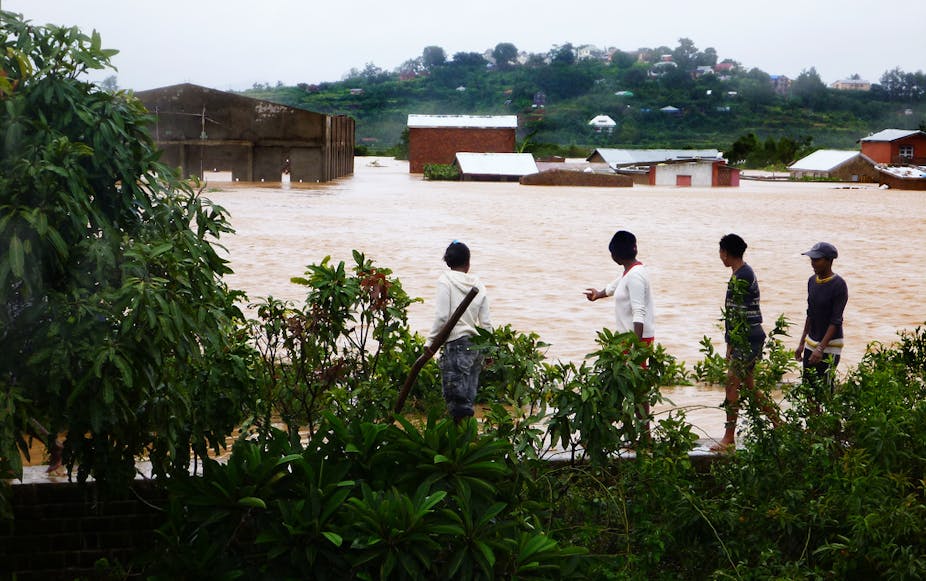Madagascar, Africa’s largest island, is naturally prone to cyclones. Earlier this year it was hit by one named Ava – a category three cyclone that killed at least 50 people, displaced over 50,000 and caused huge damage. And just this month another cyclone triggered flooding in the north of the country.
This is not unusual for the island which gets hit by an average of three to four of these aggressive storms each year.
Known as typhoons in the Pacific, cyclones are characterised by storms, torrential rain and strong winds. They vary in intensity and can be categorised into five strengths – one being the weakest (with a wind speed between 119 - 153 km/h) and five the strongest (wind speed of at least 250km/h).
The impact, both short and long term, is devastating. A great deal of the population and economy relies on agriculture which, most of time, gets destroyed in cyclones. The majority of the country’s population, more than 65%, also live in rural areas which become inaccessible when the storms hit and destroy the weak infrastructure.
This is extremely damaging to Madagascar as it’s one of the poorest countries in the world. Though it has huge marine, mineral and tourism potential, it’s very dependent on primary resources, like fishing and forestry, and has suffered from political crises, rises in global food prices and climate shocks.
Despite the frequency and damages caused by the cyclones, very little has been done to track and understand their economic impact.
For about 30 years the government of Madagascar has studied the impact of cyclones. But these tend to look at the cost of physical damage for immediate relief needs without taking the loss of services or livelihoods into consideration. This has meant that the full impact of cyclones on the economy aren’t estimated.
We set out to highlight the full impact that cyclones have on Madagascar’s economy. We’re the only centre of research in the country that is working on what we call an “economic risk atlas”. This is a tool that examines a hazard, and its intensity or magnitude, and gives the economic cost information of vulnerable assets.
By using this economic risk atlas model, policymakers can know the economic benefits of different assets in advance – and therefore where to invest in disaster risk reduction. The main advantage is that, if resources are limited, the model provides information on which vulnerable assets are a priority.
Before this model, total loss assessment had only been done once, in 2008. This was carried out by the Global Facility for Disaster Reduction and Recovery, World Bank and UN. The evaluation was done in a “Damage and Losses Assessment” (DaLA) framework. But, we’re using different techniques. Damage and losses assessment is based mainly on accounting costs of assets whereas we’re using economic valuation tools – taking into account other impacts, like health or environment. It’s a tool that could be used for other islands or any countries trying to implement disaster risk reduction, whatever the hazard.
According to our research cyclone Ava has caused about USD$ 130 million of damage and USD$ 156 million in losses. This accounts for 2.9% of the country’s 2017 GDP. Considering the national GDP growth averages about 2.5% GDP each year, this is very high. All the economic growth made over a year is blown away by one disaster.
Damages and losses
Coastal areas are the first areas to get hit and the impact is immediately felt as homes are mostly built using local, cheap material – like wood, woven mats, mud or metal sheets. These building techniques can make hundreds of thousands homeless if the cyclone is category two or higher. But they can also be considered as a local adaptation strategy. Because of the low cost and access to these materials, homes can be rebuilt in less than a week.
After the initial strike, other problems, like health issues, start to crop up. For example, because most households use open well as water sources in rural areas, it’s easy for them to become contaminated. As a result illnesses like dysentery often follow cyclones. Environmental hazards also follow as the rains can cause landslides.
Then there are the longer-term losses.
Flooding which can severely damage key infrastructure, like roads and bridges. Cyclone Ava caused damage which prevented road access to some south-eastern and south-western parts of the country. This prevents people from moving around, slows trade and production slows down all over the country.
The cyclone’s strong winds cause significant damage to infrastructure like electricity. Power cuts can last for days. Cyclone Ava destroyed 90% of the port city of Toamasina’s electricity infrastructure. This kind of damage causes huge losses to livelihoods and the local economy.
One of the biggest, and most important, losses is the temporary or permanent loss of jobs. In Madagascar, the informal sector accounts for more than 80% of jobs and this sector is heavily affected when cyclones strike. Cyclone Ava caused a job loss of 40%, of which 90% were from the informal sector.
Recovering from these losses is very challenging. People don’t have insurance to claim on damage that is done to crops, goods or livestock. For those in the informal sector there is no government support to fall on if they lose their jobs.
Madagascar needs to invest more, and strategically, in prevention and in disaster risk governance to decrease the costs of future disasters. The economic risk atlas is a scientific tool which would be useful in assisting in this process.

